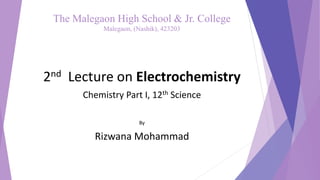
Electrochemistry lecture on variation of conductivity and molar conductivity with concentration
- 1. The Malegaon High School & Jr. College Malegaon, (Nashik), 423203 2nd Lecture on Electrochemistry Chemistry Part I, 12th Science By Rizwana Mohammad
- 2. Variation of conductivity with concentration: • Conductivity decreases with decrease in concentration of solution. • The electrolytic conductivity is electrical conductance of unit volume of solution. • It depends on number of current carrying ions present in unit volume of solution. • On dilution total number of ions increases as a result of increased degree of dissociation. • An increase in total number of ions is not in proportion of dilution. Therefore, the number of ions per unit volume of solution decreases. Variation of molar conductivity with concentration: • The molar conductivity is the electrical conductance of 1 mole of an electrolyte in a given volume of solution. • The increasing number of ions produced in solution by 1 mole of the electrolyte lead to increased molar conductivity.
- 3. Variation of molar conductivity with concentration: • The variation of molar conductivity with concentration in case of strong and weak electrolytes is quantitatively different. i. Strong electrolytes: • The molar conductivity of solution of strong electrolyte increases rapidly with dilution. • It approaches the limiting value for 0.001M or 0.0001M solution. • The dilution has no effect on molar conductivity thereafter. • The maximum limiting value of molar conductivity is the molar conductivity at zero concentration or at infinite dilution. • It is denoted by Λ0. • The zero concentration or infinite dilution means the solution is so dilute that further dilution does not increase the molar conductivity.
- 4. • The molar conductivity of strong electrolytes varies linearly with square root of concentration as: Λ = Λ0 - a C a = constant ii. Weak electrolyte: • For weak electrolytes the variation of Λ with C is not linear. • Λ0 for strong electrolytes can be determined from graph directly. • Λ0 for weak electrolytes can not be determined from graph directly. • Kohlrausch law is useful for calculating Λ0 of weak electrolytes. Variation of Λ with C
- 5. Kohlrausch law of independent migration of ions: The law states that at infinite dilution each ion migrates independent of co-ion and contributes to total molar conductivity of an electrolyte irrespective of the nature of other ion to which it is associated. Thus Λ0 = n λ0 + n λ0 λ0 and λ0 are molar conductivities of cation and anion respectively. n and n are the number of moles of cation and anion. Applications of Kohlrausch theory: The theory can be used to calculate the molar conductivity of an electrolyte at the zero concentration. e.g. Λ0(KCl) = λ0 K + λ0 Cl Λ0(Ba(OH)2) = λ0 Ba2 + 2λ0 OH Knowing the molar conductivities of ions at infinite dilution, Λ0 values of electrolyte can be obtained. + -+ - + + - - + - + -
- 6. • The theory is particularly useful in calculating Λ0 values of weak electrolytes from those of strong electrolytes. e.g. Λ0 of acetic acid can be calculated by knowing those of HCl, NaCl and CH3COONa as below: Λ0(HCl) + Λ0(CH3COONa) - Λ0(NaCl) = λ0 H + λ0 Cl + λ0 CH3COO + λ0 Na - λ0 Na - λ0 Cl = λ0 H + λ0 CH3COO = Λ0(CH3COOH) Thus, Λ0(CH3COOH) = Λ0(HCl) + Λ0(CH3COONa) - Λ0(NaCl) Because Λ0 values of strong electrolytes HCl, CH3COONa and NaCl can be determined by extrapolation method, the Λ0 of acetic acid can be obtained. + - + - - + + -
- 7. Molar conductivity and degree of dissociation of weak electrolytes: α = ΛC Λ0 where ΛC is the molar conductivity of weak electrolyte at concentration C, Λ0 is molar conductivity at zero concentration. Measurement of conductivity: The conductivity of a solution can be determined from the resistance measurement by Wheatstone bridge.
- 8. Conductivity cell: Conductivity cell • The conductivity cell consists of a glass tube with two platinum plates coated with a thin layer of finely divided platinum black • It is obtained by the electrolysis of solution of chloroplatinic acid. • The cell is dipped in a solution whose resistance is to be measured.
- 9. Cell constant: The conductivity of an electrolytic solution is given by k = 1 R l a l a = cell constant SI unit of cell constant is m-1 k = cell constant R The determination of conductivity consists of three steps: 1. Determination of cell constant: • The cell constant is determined using the 1M, 0.1M or 0.01M KCl solutions. • The conductivity of KCl solution is well tabulated at various temperatures. • The resistance of KCl solution is measured by Wheatstone bridge.
- 10. • AB is the uniform wire, Rx is the variable known resistance placed in one arm of Wheatstone bridge. • The conductivity cell containing KCl solution of unknown resistance is placed in the other arm of Wheatstone bridge. • D is a current detector. • F is the sliding contact that moves along AB. • A.C. represents the source of alternating current. • The sliding contact is moved along AB until no current flows. • The detector D shows no deflection, the null point is thus obtained at C. Measurement of resistance
- 11. • According to Wheatstone bridge principle Rsolution l(AC) = Rx l(BC) Hence, Rsolution = l(AC) l(BC) Rx ∴ Cell constant = kKCl X Rsolution 2. Determination of conductivity of given solution: • Now, KCl solution in the conductivity cell is to be replaced by the given solution whose conductivity is to be measursed. • Its resistance is measured by the process described in step 1. • The conductivity of given solution is then calculated as: k = Cell constant Rsolution 3. Calculation of molar conductivity: • The molar conductivity of the given solution is calculated using following equation. Λ = 1000k C
